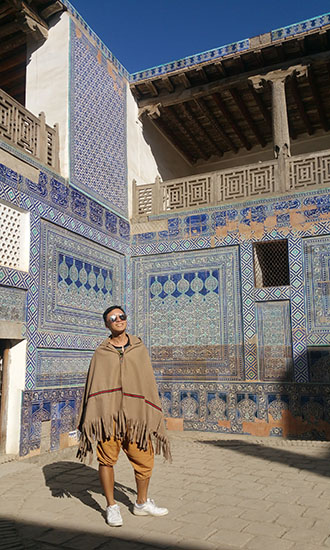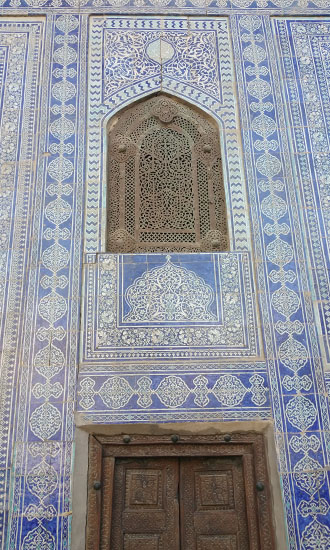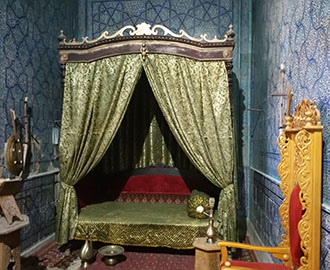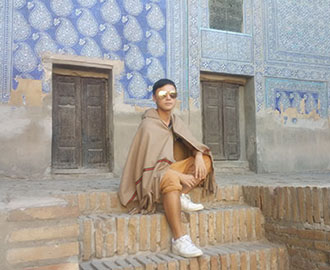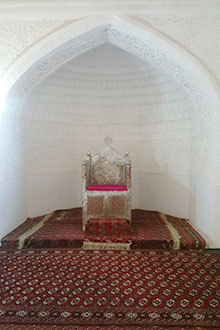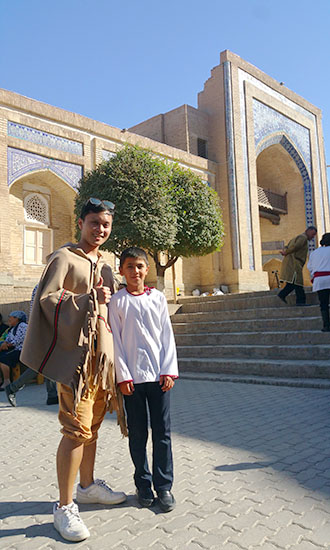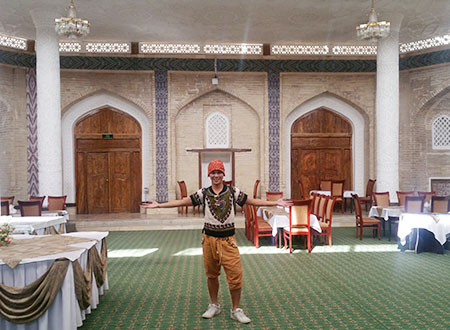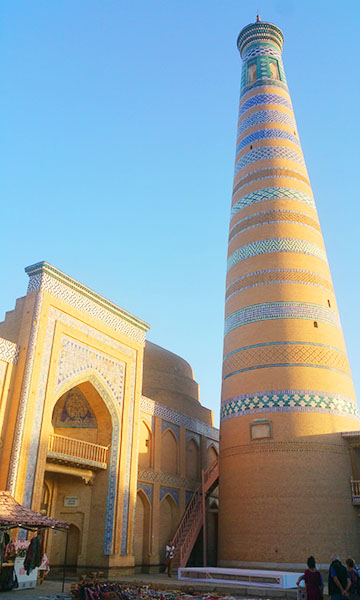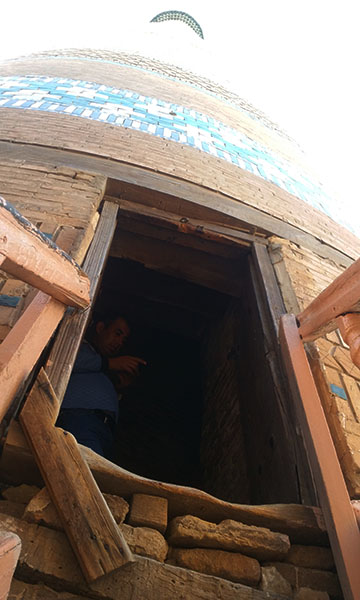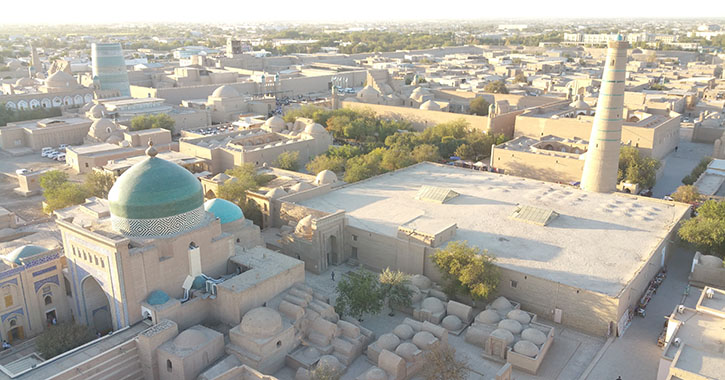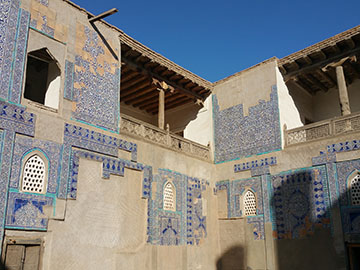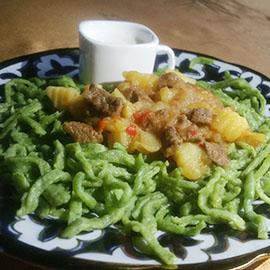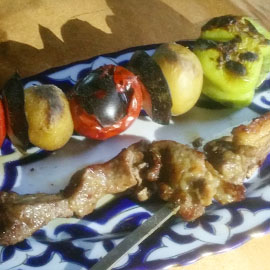|
Uzbekistan |
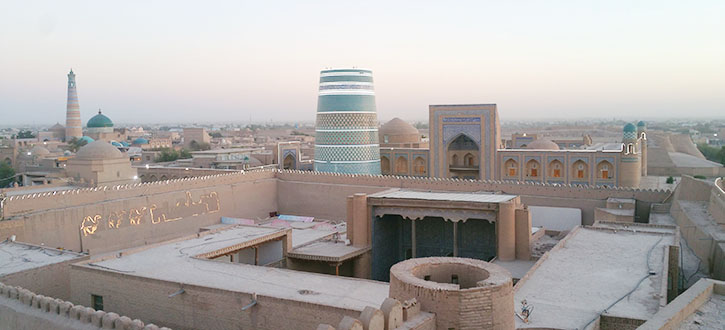 |
| On September 14-24, 2018,
Ricky, Caxton and I explored the Central-Asia, focusing on Uzbekistan.
The reasons for venturing this area are that:
(i) we haven't been to the region; (ii) with the passing away of the long term president in 2016, Uzbekistan just tunes itself more friendly for tourism which would offer a more authentic experience for earlier traveller; (iii) China's Belt and Road Initiative strives to revive the ancient silk road route, so it would be interesting to understand the history of the area; and (iv) the country is full of many UNESCO sites. Our journey begins from the most rural to urban, i.e. from Khiva > Bukhara > Nurota > Samarkand > Tashkent. |
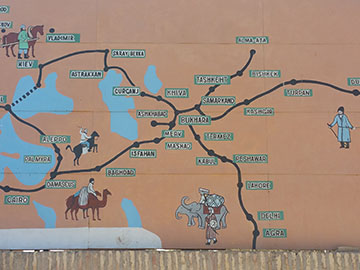 |
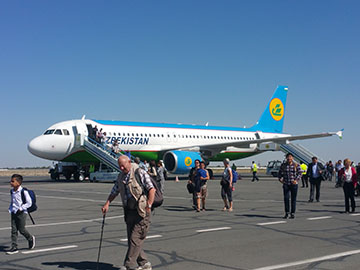 |
| The ancient silk road was the route for trading amongst the (1) East from China, (2) South from India, (3) West from Persia, and (4) North from Europe. The current Uzbekistan, covering Khiva, Bukhara and Samarkand, represents the heart of the ancient silk road. The cities had their glorious days, being the world's trading centres, but reduced to be deserted as a result of the rise of the marine trade route in the 19th cen. Empire rises and falls are just history... And now we can explore all by internal flights. |
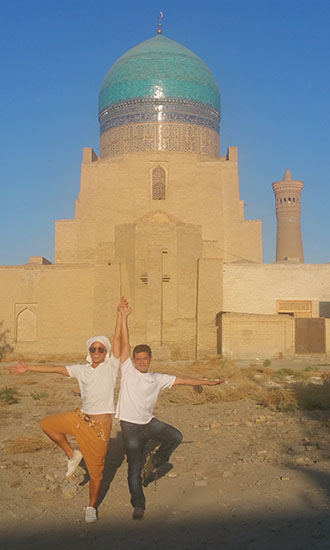 Bukhara old town with the signature minaret. |
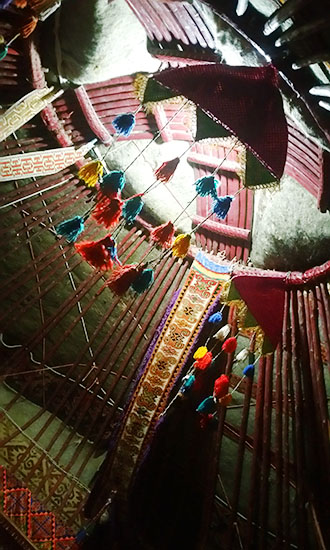 First time I stay in a yurt in a desert. |
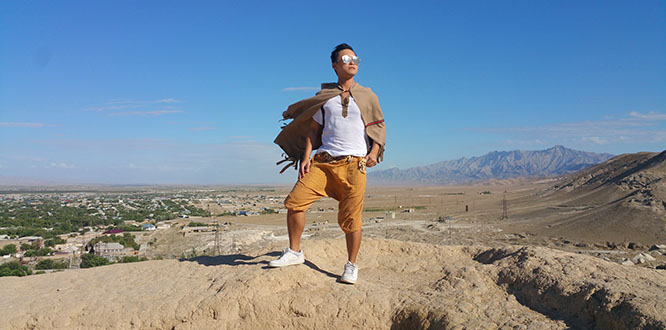 Nurota. I am atop of the fortress erected by Alexander the Great back in 2,300 year ago. The fortress is strategically located at a mountain rim protecting the land below and also as a back up stop while Alexander conquered the further east. |
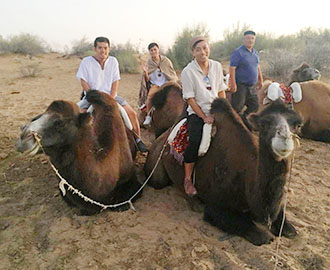 Great to have companies |
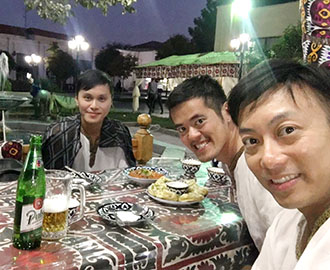 Ricky and Caxton. MMM |
| Khiva |
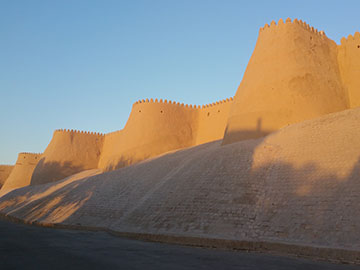 Khiva old town (Itchan-Kala) is a walled city with 4 gates on 4 sides. This west wall contains the oldest section dated back to 5th cen. |
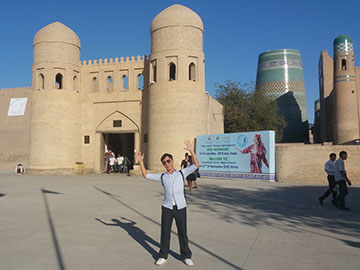 The main entrance to the walled city is the west gate as it's where the main palace and locates. The east gate was mainly for caravans and merchants. |
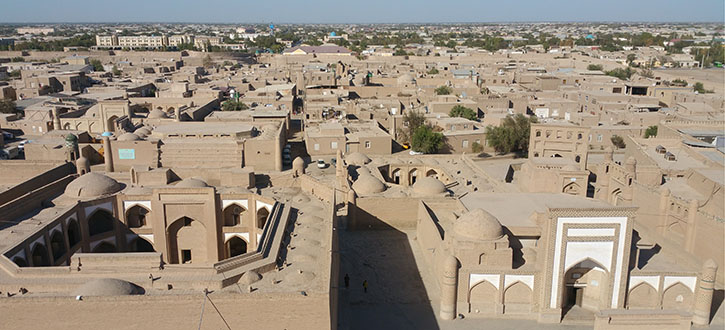 View of the Itchan-Kala from the middle looking north. The whole Itchan-Kala is a rectangular area of 650m by 400m. The town center is just 3 streets from west to east. Structures inside the wall were (re)constructed with sand stone under Islamic architectural style. Mainly Itchan-Kala is a tourist quarter nowadays. Outside of the wall is the new town where locals live. |
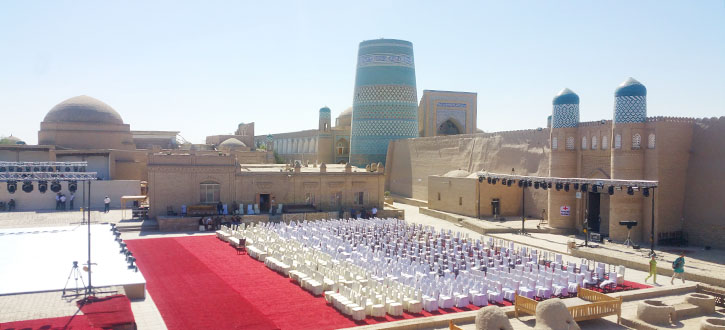 In Khiva, or the whole Uzbekistan, all historical sites are primarily (i) mosque, (ii) madrassah (college), (iii) minaret (bell tower to remind people to pray), and (iv) masusoleum (tomb). There are 94 mosques and 63 madrassahs in Khiva. Not sure if it's a blessing, while under Soviet rules, religion was banned and the strict Islam religion rule was a bit relax now in Uzbekistan. This picture captured quite some major elements
of Khiva: (i) the Kuhna Ark (the palace on the right), (ii) Zindan (the jail on
the right side of the palace gate), (iii)
Kalta Minor Minaret (the turquoise icon of Khiva), (iv) Muhammad Amin
Khan Medressah
(now a hotel behind the minaret), (v) the main square (front of picture)
famous for public execution and the long history of slave trade of Khiva
which lasted until 1917, and (vi) Palvan Kori Trading Centre (beside the
square) for trading of goods in the past. |
|
|
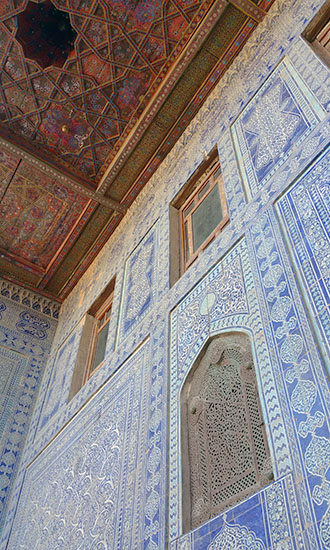 Though now Khiva and Bukhara are within the same country, they were rivalry as trading centres in the Central Asia in the past. |
|
|
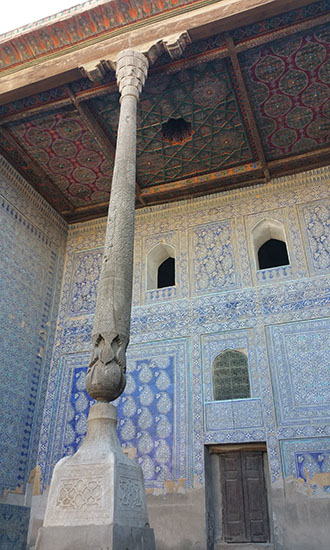 As Khiva, being an oasis in a desert, is quite hot during summer, the reception hall was designed with tall ceiling to channel wind from higher ground. In winter, a yurt would be set up at the open area with fire heating in the center. |
|
|
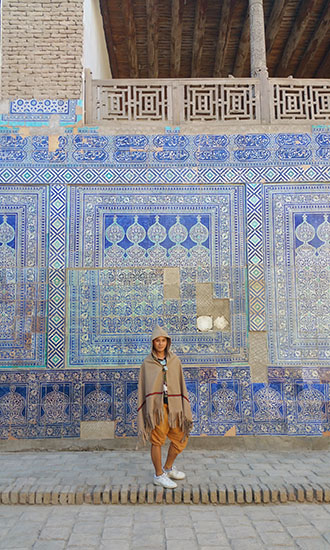 The reception hall of the new palace has been kept in original facet under UNESCO suggestion. |
|
|
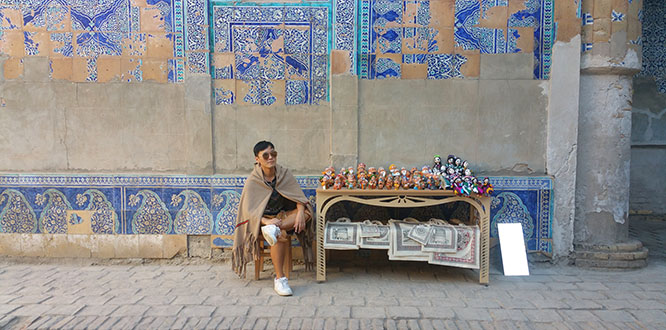 |
|
|
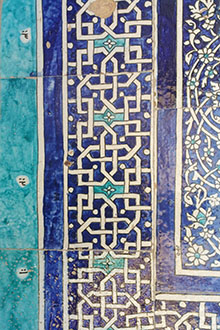 Tiles were labelled during construction. |
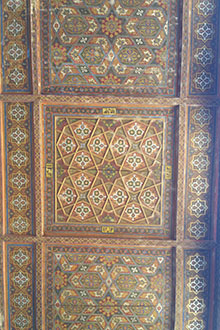 Roof of reception hall. |
|
|
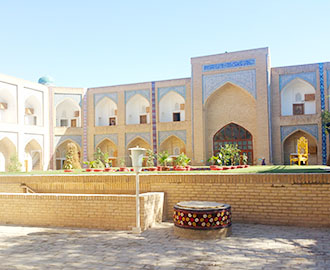 Madrassah was a 5 years education like university. Each madrassah specialized in a subject like religion, literature, science, etc. The chambers around the courtyard was the dormitory. |
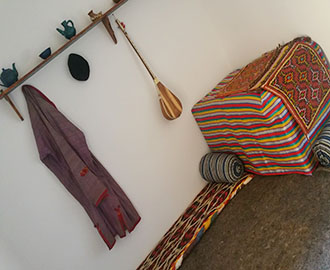 Each room housed 2 students and only male could go study then. |
|
|
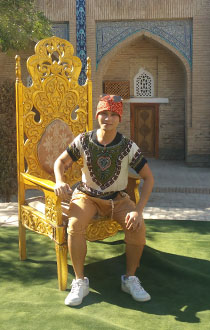 A stage for a play. I'm a Khan. |
|
|
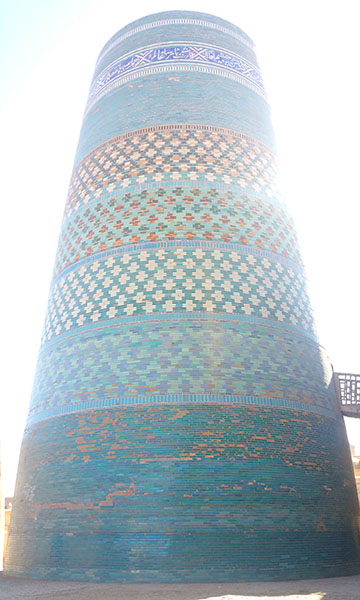 Kalta Minor (short minaret). The iconic symbol of Khiva. Dated from the 19th cen. After Muhammad Amin Khan's death in 1855, the minaret remained incomplete as the next Khan would rather build other structure bearing his name. |
|
|
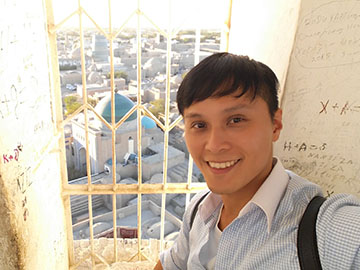 |
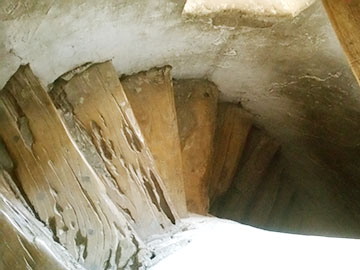 Here is the steep staircase climbing up the minaret. Please bring flashlight. |
|
|
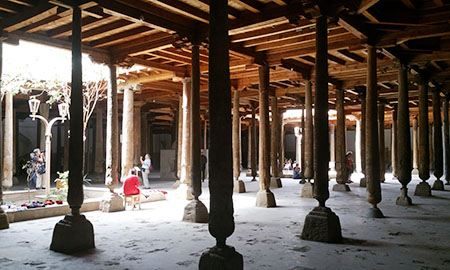 Jummi Mosque (or Friday Mosque as Muslim pray on Friday). Built in the 10th cen. which contains 212 carved columns. As Khiva is a desert, caravans were requested to bring construction supply along with the trade. |
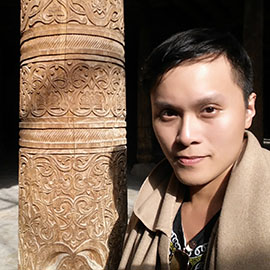 This column was from India. Hidden herewith the motifs of Buddha sitting on lotus pot. |
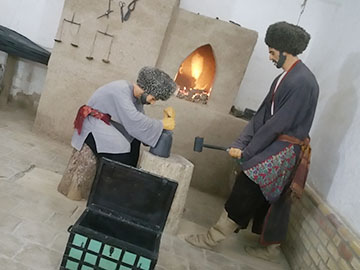 As Khiva was a trade center, it minted it own coins and notes to facilitate trading in one currency. |
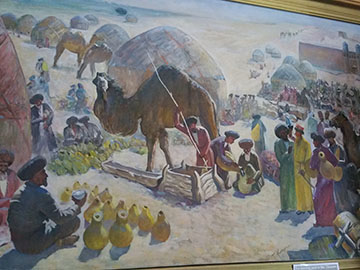 Painting depicting what caravans and trading was like back in time. |
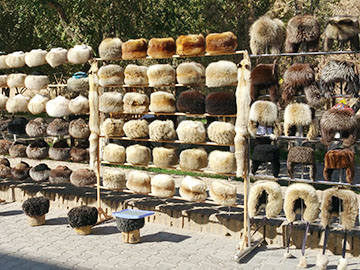 The signature hat for Khiva. |
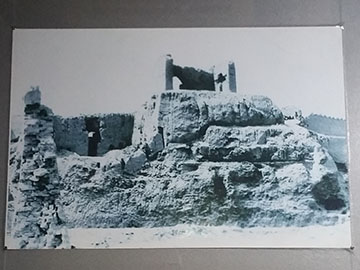 Discovering Khiva back in 1970s. |
|
|
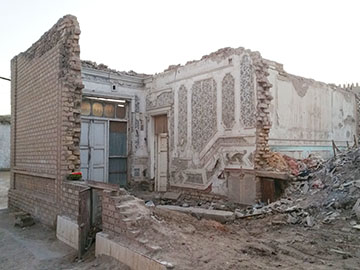 Structure outside of Itchan-Kala was destroyed by the 1966 earthquake. |
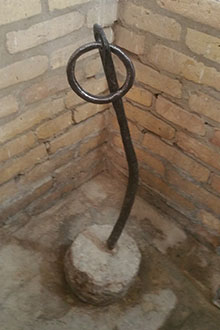 Slaves were chained with stone on their legs. |
 Big door knock to indicate a male is coming. |
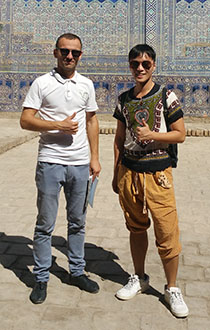 Our guide. 24 yo born and raised in Itchan-Kala. |
|
|
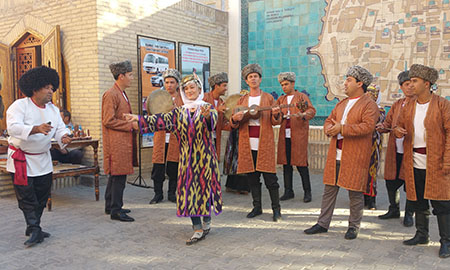 Fashion and traditional dance show. |
|
|
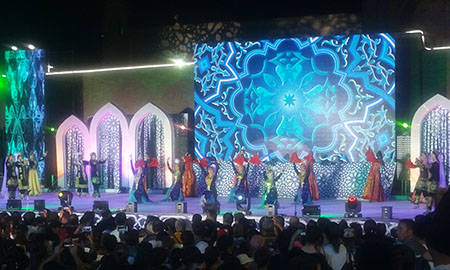 There was Central Asia dance competition in the Itchan-Kala on the exact days we stayed. |
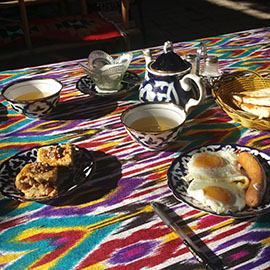 Enjoyed tea and post card time at Teahouse Farrukh, right at the town center. |
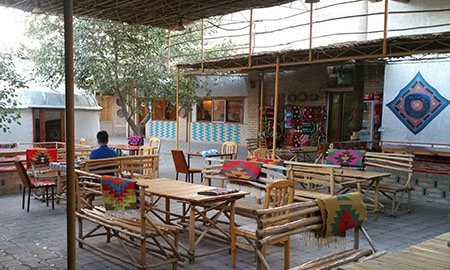 All hotels were taken so we stayed at this Teahouse Farrukh hostel, which was a madrassah conversion. The owner was very caring and we felt the hospitality and warmth. |
|
Bukhara |
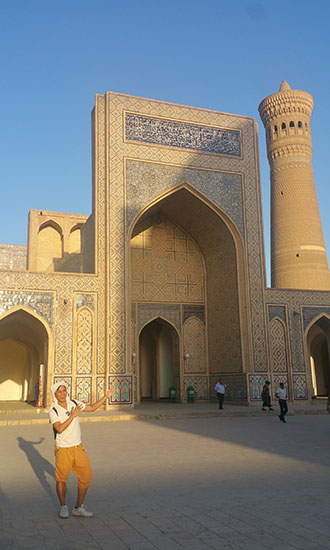 Bukhara can be tracked back to 4th cen. The old town of Bukhara scratches 2~3 km. The main square was surrounded by (i) Po-i-Kalyan Mosque, (ii) Kalyan Minaret, and (iii) Mir-i-Arab Madrassah. The landmark of Bukhara is the Kalyan Minaret, which was erected in 1127 on top of the grave of an imam (a priest) killed by the Khan. Here I am inside the mosque pointing to the minaret outside. |
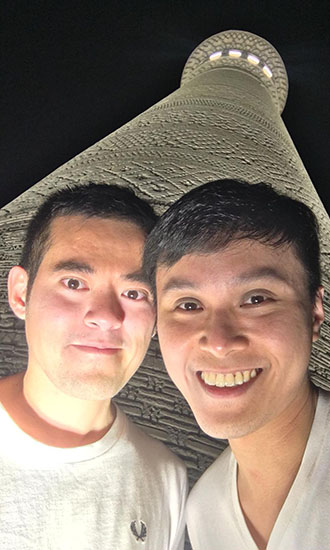 Back when Genghis Khan conquered Bukhara, wind blew his hat off to the ground and he bowed down to the tower to pick up the hat. So he spared the minaret and destroyed and burnt everything else with his 15 days in the town... The minaret was also nicknamed "Tower of Death" as criminals were pushed out of the tower as public execution which practice lasted until early 1900s. |
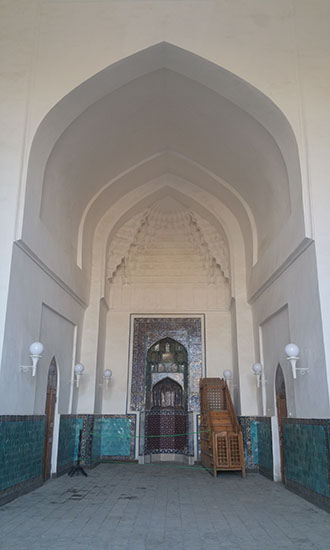 The seat of imam inside the Po-i-Kalyan Mosque. |
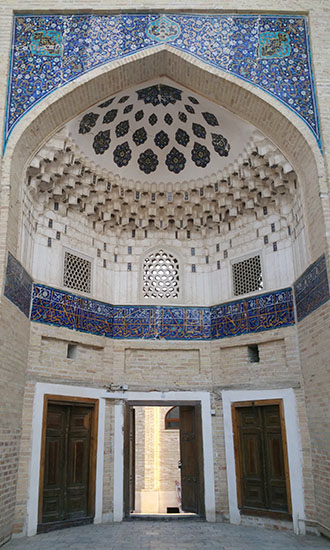 The entrance gate of Mir-i-Arab Madrassah. |
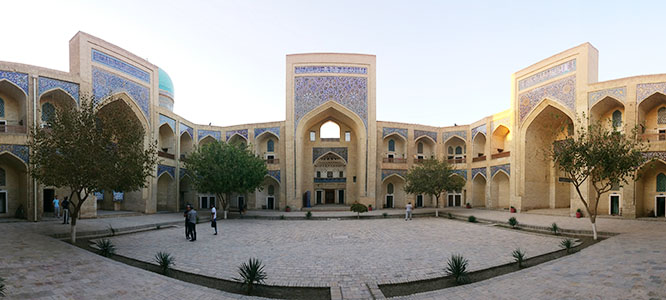 The Mir-i-Arab Madrassah is still an active education institution with students living here. Entrance to the madrassah is restricted, yet the side gate was open so I had a glimpse of the dorm and courtyard. |
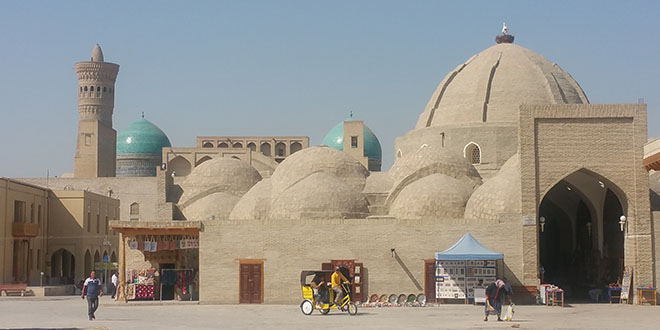 Taqi Sarrafon. Bazaar of currency exchange, dating back to 16th cen., is one of the three surviving trade domes in Bukhara. The other trade domes were for jewellery and cap (hat). Now they just sell souvenirs. |
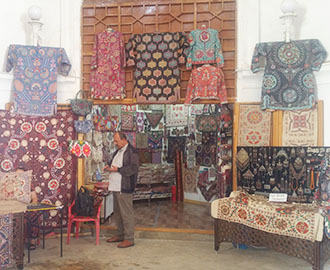 |
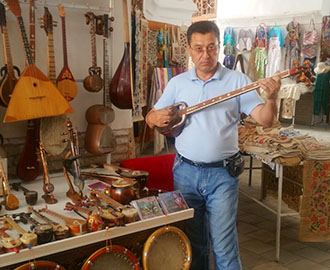 |
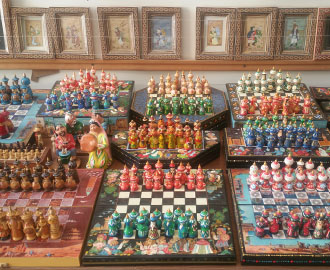 |
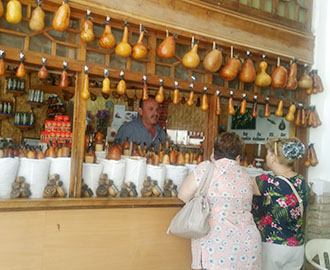 |
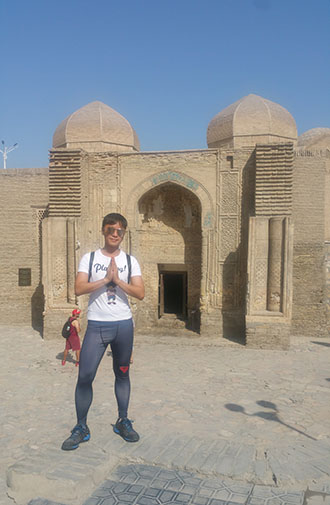 Magoki-Attari Mosque is the oldest mosque in Bukhara dating from the 12th cen. The ancient ground level is at least 1.5 meter lower than the current one. |
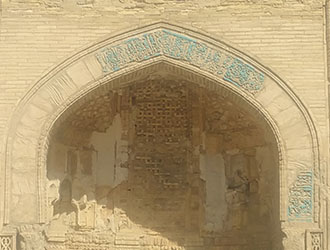 The turquoise tiles and the arch are in their original state and color. |
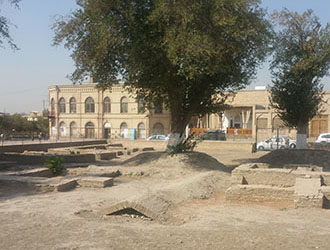 This ancient site is yet to be excavated. The structure behind the tree was a bank built under Soviet time in European style. |
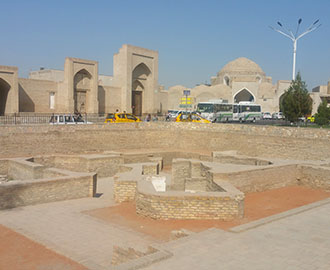 This site was a bath. At ancient time people didn't have private bath, so opted for a public one. |
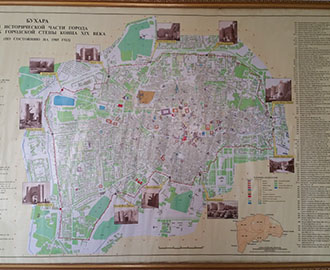 In 10th cen., Bukhara constructed 11 gates to protect the city. The old town is in the middle. |
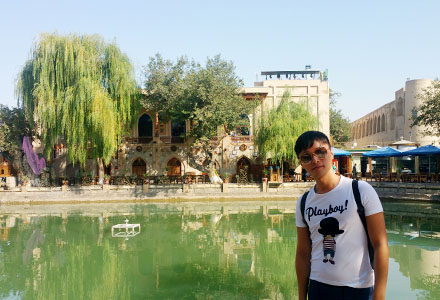 Lyabi Khauz (gathering pond). This is the water reservoir in the heart of the Bukhara, which has been much of a gathering place for the locals. Bukhara situates in between two rivers, so canals where built to channel water supplies. |
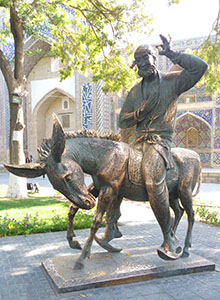 Beside the pond staged Khodja Nasreddin statue, an ancient "wise fool" who was a legendary Uzbek Robin hood. |
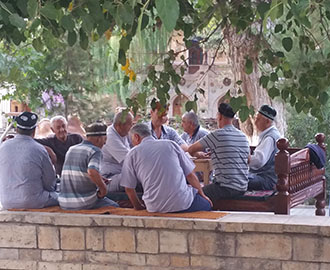 Locals hanging out to play chess. These trees were at least 200 years old. Definitely a good place to chill under the sun. |
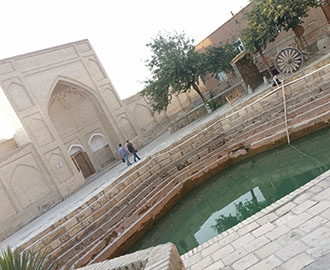 Another reservoir just 200m away from Lyadbi Khauz. These reservoirs were constructed in stairs, so can walk down for water. |
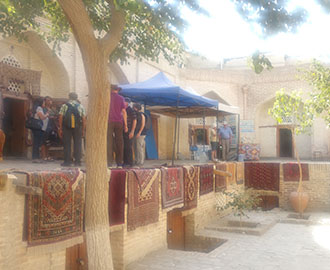 Opposite of the pond is an ancient caravanserai, an inn for caravan. Each caravan, comprised 40~50 people, would occupy the whole complex for securities. |
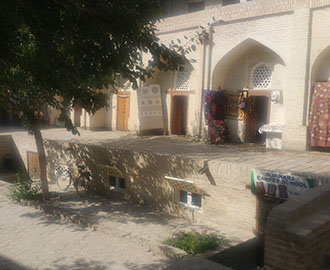 The upper floor was for sleeping. The lower floor was for storage of trades and goods, while camels rest at the middle court. |
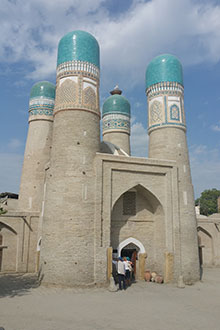 Chor Minor, a mini mosque outside the old town. |
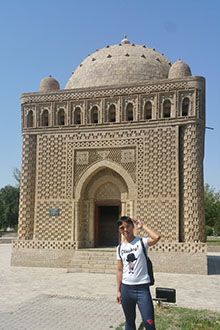 Samanid Mausoleum. Tomb of the early ruler of Bukhara in 10th cen. |
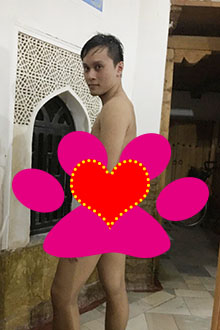 Hammon Borzi Kord, a 600+ yo bath house. US$20 for tourist for a 50 min experience. |
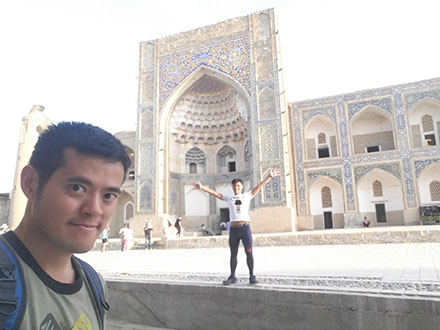 Another madrassah, yet UNESCO suggested it to keep its original facet untouched. |
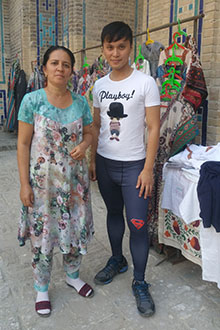 These madrassahs are mainly souvenir shops now. |
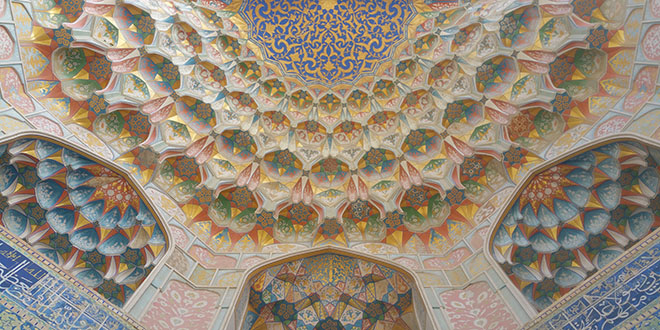 They claimed all the paints were from organic sources. |
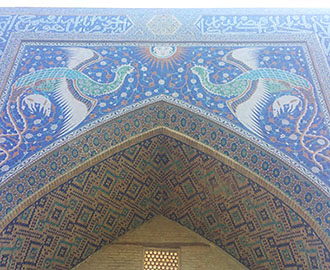 Unique portal of Nadir Divan-Beghi Madrassah (17th cen.) featuring 2 phoenix, 2 misshapen white deer and a "man-in-the-sun" face. |
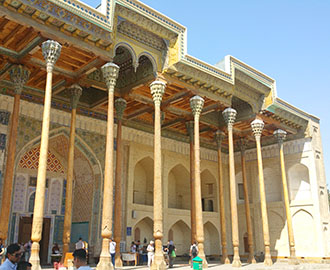 Bolo Haouz Mosque (18th cen.) is a unique rectangular mosque. The painted columns were added in 1917. |
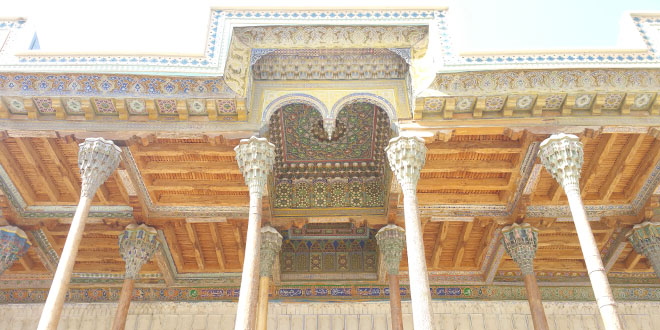 The spacious open area was designed as a summer praying zone. |
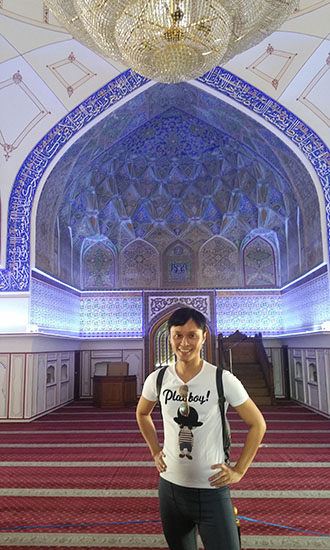 The inside was designed as a winter praying room. |
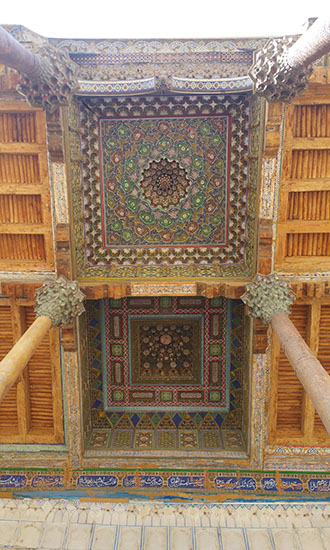 The roof is 12m tall supported by 20 wood columns. |
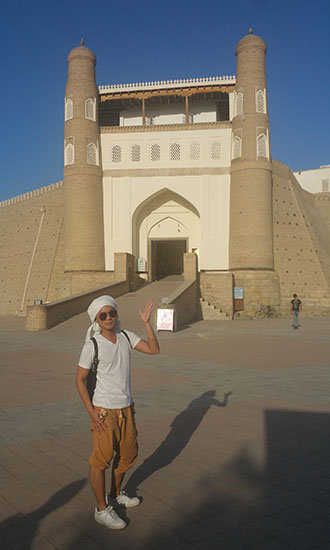 Ark Citadel. The fortified residence of Bukhara rulers. Over 80% was reconstructed. It is now a museum. |
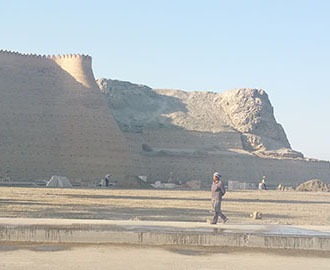 Reconstruction of the fortress. |
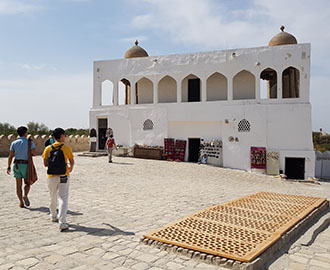 Top floor was for announcement; lower floor was for surveillance. |
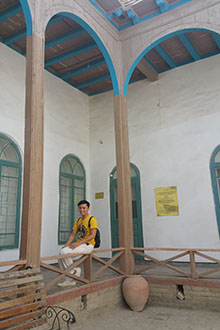 Some area of the Ark. |
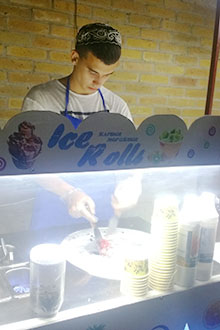 Cute boy frying ice-cream |
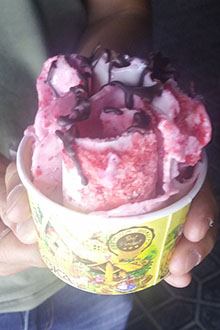 We paid US$1.5 while locals was just US$0.5 |
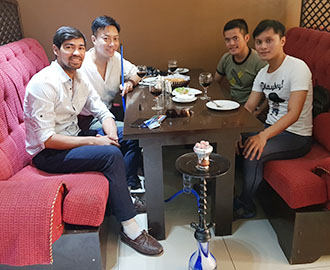 Our guide, who also brought us for shisha and local men's health spa, with gym, pool, steam and sauna. |
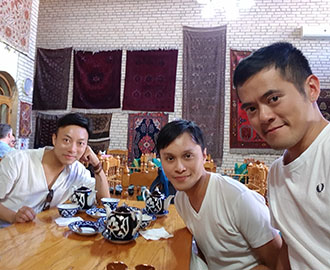 Silk Road Tea House. US$3 for a tea. A good place to hide from the heat that last until 4pm in Sept. |
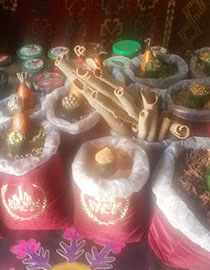 Tea spices (from india) |
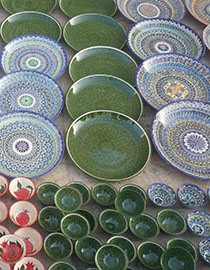 Ceramics |
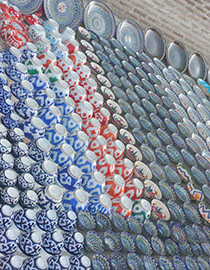 Perhaps from China |
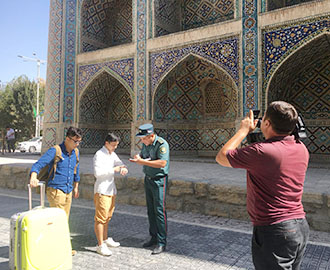 |
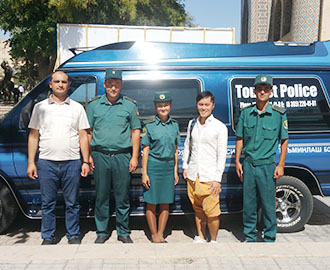 |
| Upon our arrival to the Bukhara airport, we were approached by Bukhara Tour Police for the filming of their service promotional video. So in the clip, I pretend that I left my bag at airport and they helped me to locate and deliver it back to me. Overall, we earned a free ride from airport to hotel and an interesting acting experience. |
|
Nurota |
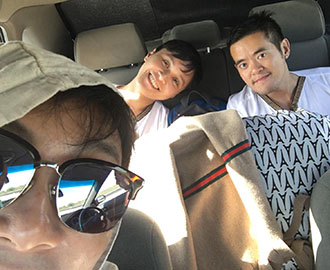 After Bukhara, we took a private ride to Nurota, US$60 per day. |
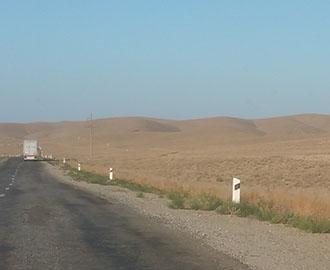 It's a 4 hours journey through a desert. |
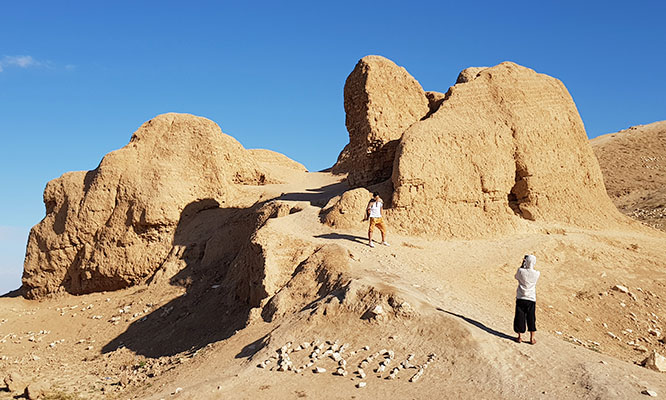 Here we arrived the fortress constructed by Alexander the Great back in 327 BC. There isn't much to see except for a few mud walls and fortifications up on the hill. Yet the connection of these structures in a desert to Alexander the Great is already worthy journey of the history. |
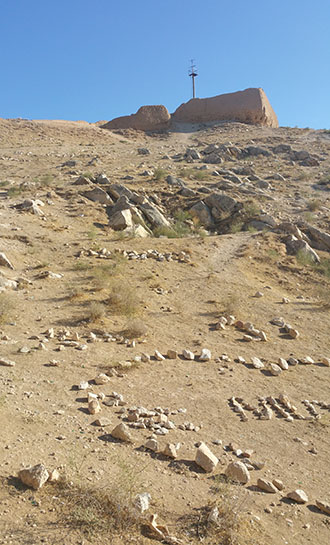 |
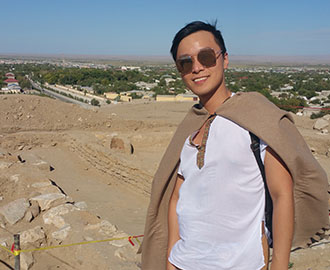 |
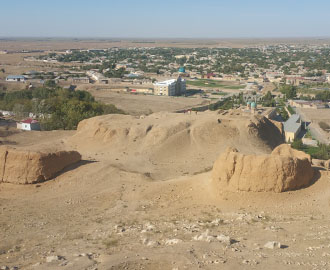 |
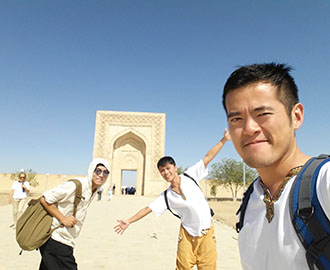 Thru the desert we passed by Rabat-Malik, an ancient caravanserai. |
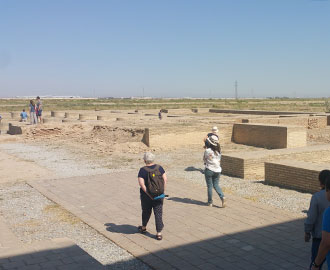 Mostly caravans stayed at yurt. Occasionally stayed at caravanserai for better rest. |
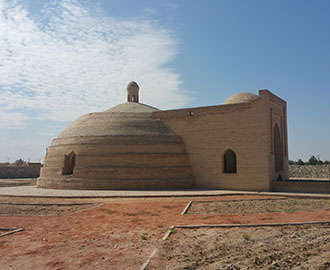 Sardoba (reservoir) near Rabat-Malik. This is the largest and most ancient water storage. Water was collected not only by melting water but from the river Zarafshan. |
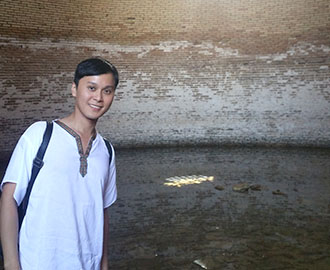 As silk road journey took 2 months, sardoba were set along the caravan route to preserve water under ground level covered by a dome. |
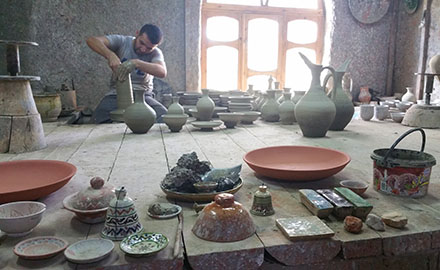 Central Asia doesn't really have its own signature products. Silk, china, tea, spice, bronze, carpets, mechanics were trade products from surrounding regions. Perhaps ceramic is Uzbek's thing. This ceramic family factory has history over 200 years. |
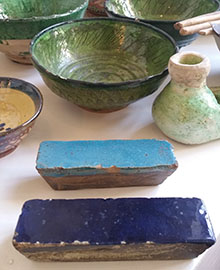 It has manufactured glazed tiles for the exterior of famous minaret, mosque, madrassahs in Uzbekistan. |
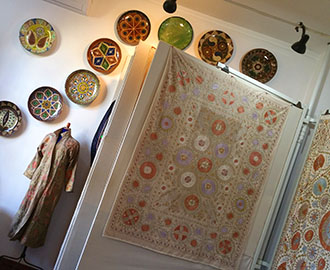 This silk textile was completed by hand by 5 labours for 2 months. |
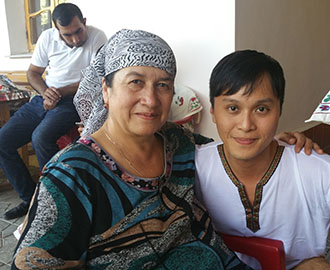 We had lunch at this family home. |
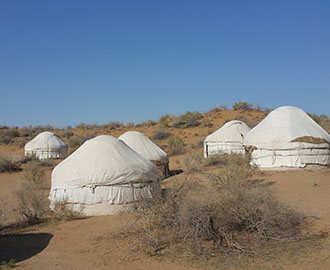 We spent a night at Safari Yurt, 60 km from Nurota, at the border of sandy Kyzyl Kum Desert and Aydarkul Lake. We wondered why they set up the camp so far away whilst it was already nothing in a 10 min ride from anywhere. |
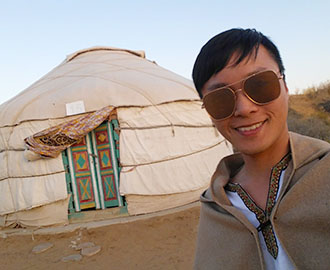 Food was plain mediocre. The bonfire and dance was a joke. We got our own yurt (5 beds) for US$150 total. It's a purely "stay at a yurt" experience that has some room for improvement. |
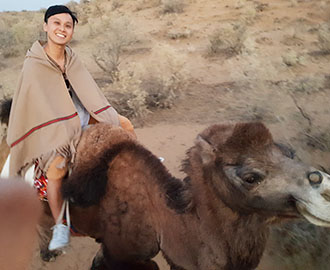 We also enjoyed a camel ride off a sand dune for 15 minutes. |
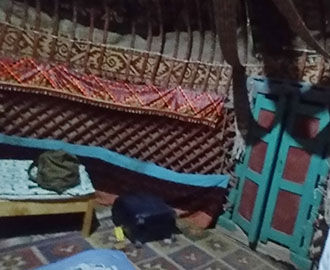 The yurt was constructed with bamboo, leather, fur and blankets to keep warm. |
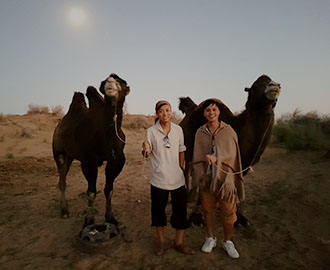 One can rent her for a 3 hours journey to the nearby Aydarkul Lake. |
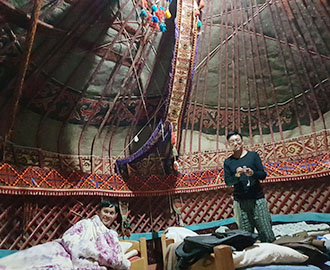 It's September. Temperature at night was 15C. I dressed warmly so had a good night sleep. |
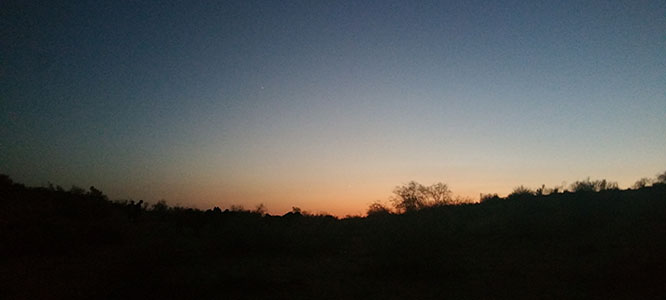 September 20, 2018 今天我和两位朋友在中亚沙漠的蒙古包度过。晚上在过万颗闪锐的星星和漆黑一片的天空下,我和Ricky远走了一段路程,听着王菲的经典歌曲,回顾过去及谈论现在的近况。我们也曾经经历过人生的挫折,痛苦过,现在生活也算过的满意的。人生不能拥有所有东西,只要知足、满足、珍惜、而常乐。这时这刻我感觉得很幸福。家庭、朋友、健康、事业也算过得如意。心存感恩的微笑。同时这刻抬头一看,一颗流星划过星空,我还可以祈求什么呢。 |
 The Aydarkul Lake covering the size of 4,000 sq.km is an unintentional man-made lake from a negligent Soviet water system planning that resulted in the drying up of Aral Sea. This area used to be a plain desert. |
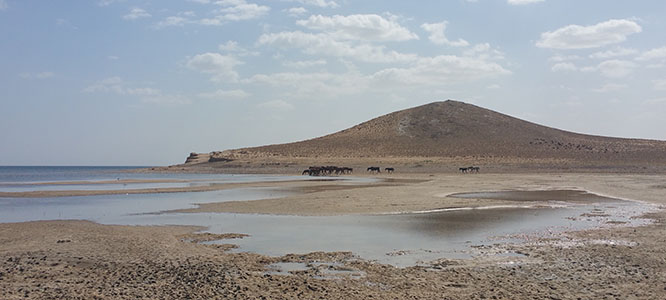 Those are horses drinking water. |
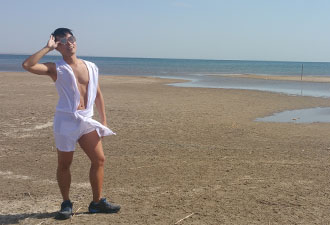 Planned for a swim, but chickened out as sands look muddy. |
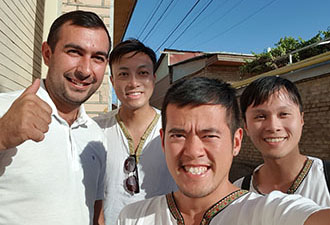 Our driver for 2 days. A very nice and sincere 26 yo guy. |
|
Samarkand |
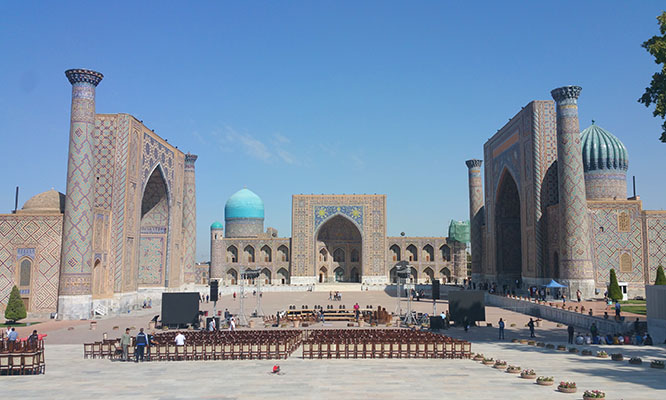 Registan Ensemble. The gathering square, and the jewel of Samarkand, is surrounded by 3 madrassahs with Ulugbek and Shirdor facing each other in similar facade and Tilla Kari in the middle. They were constructed in the 15th to 17th centuries. |
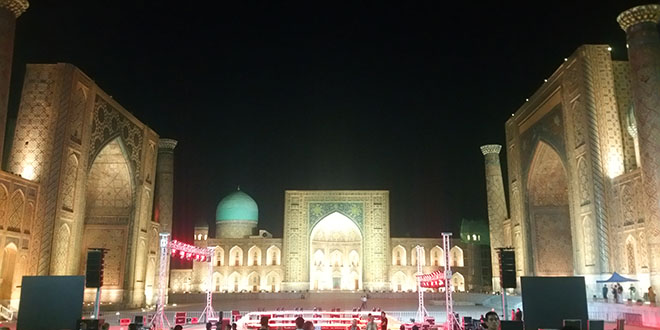 Samarkand dates back to 600 BC and was conquered by Alexander the Great in 329 BC. "Everything I've heard about the glories of Samarkand is true, with the exception of one thing - the city is much more beautiful than I could ever imagine" - Alexander the Great Yet in 1220, Samarkand was mostly destroyed by Genghis Khan. |
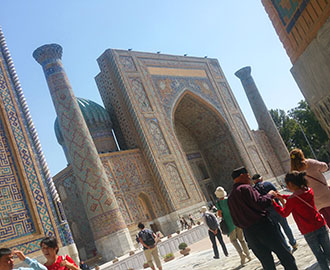 Shirdor Madrassah |
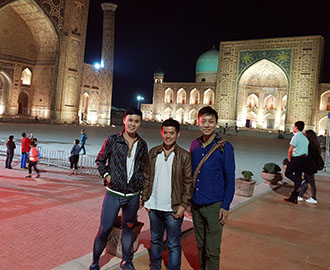 Night entrance was possible by directly paying the police. |
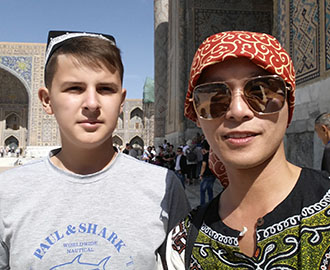 Met a group of boys touring from an unheard of town in Uzbek. They wanted picture with Caxton. Well, I did capture one in reciprocity. |
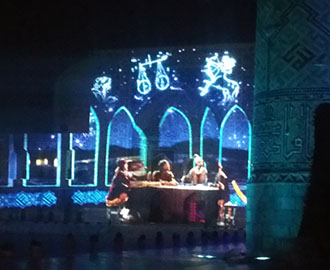 Light show projecting at the madrassahs, presenting the history and development of Uzbekistan. |
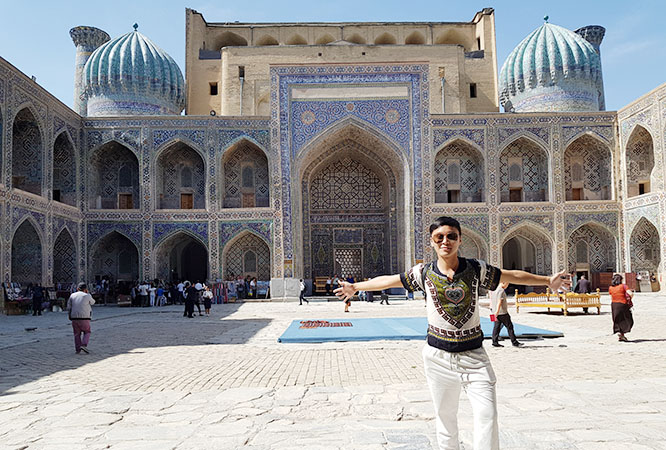 Shirdor Madrassah has a mosque and classrooms at four corners, while the cells surrounding the yard are dormitory. |
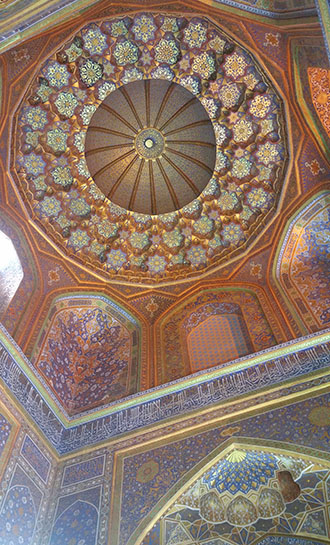 The ceiling of Tilla Kari Madrassah is actually flat. |
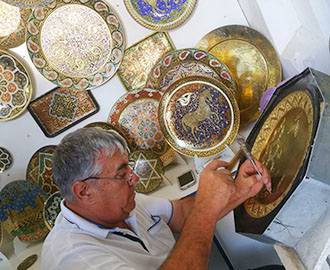 |
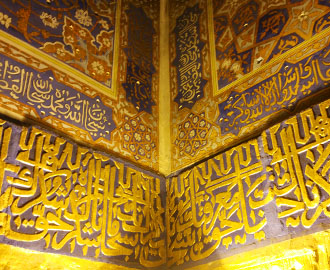 Inscription of the history of the madrassahs. |
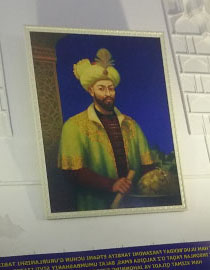 Ulugbek ruled Uzbek, Tajik, Turkmen, Kyrgyz, southern Kazakh and most Afghan-istans from 1411 to 1449. |
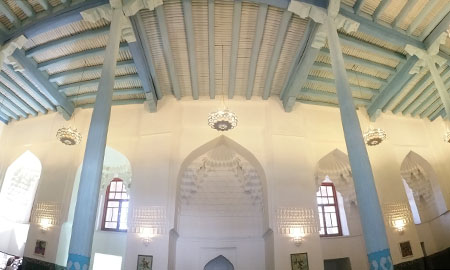 He was the grandson of Amir Timur and was also an astronomer, scientist and architect. His work greatly advanced the studies in Central Asia. This hall was his residence and astronomy research centre. His observatory was at city north but was destroyed under Soviet time. |
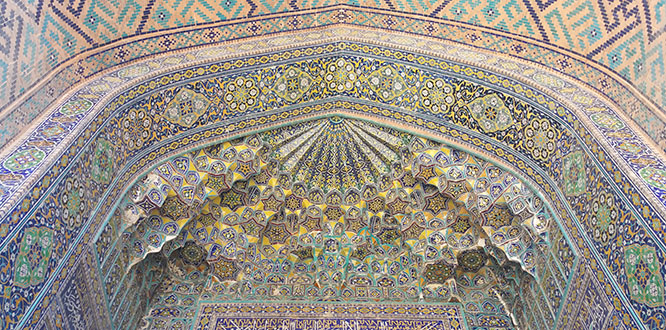 The Ulugbek Madrassah was constructed under his era in 1420. |
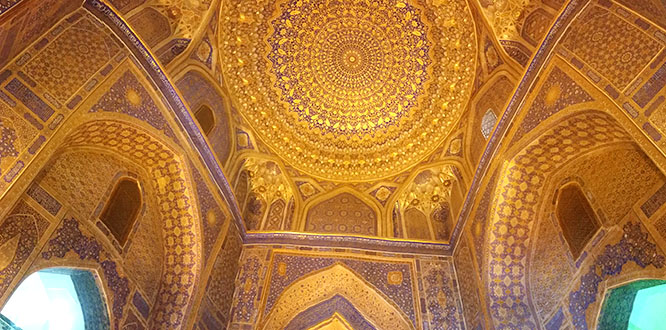 It is the oldest of the three madrassahs with more refined ornaments and decorations which consist of glazed and unglazed bricks, mosaics, majolica, carving marbles. |
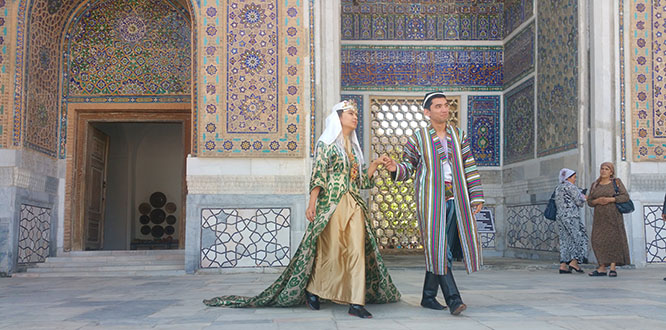 Wedding picture at Ulugbek Madrassah under traditional gown. |
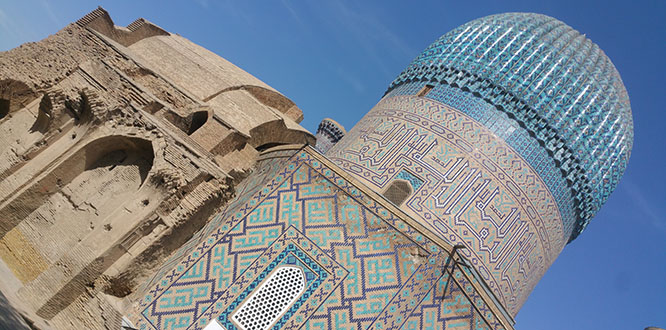 Gur Emir Mausoleum (Amir Timur Mausoleum). Amir Timur (1336-1405), a male-line descendent of Genghis Khan, was the founder of the Timurid Empire in Persia and Central Asia. His great-great-great-grandson Babur (1483–1530), founded the Mughal Empire. |
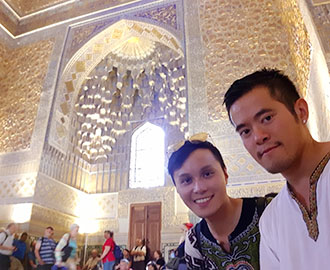 Inside the Gur Emir Mauseleum. |
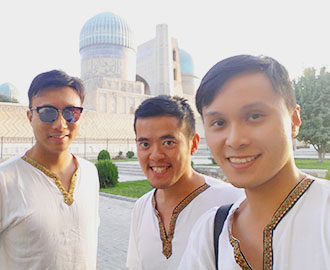 Bibi Khanum Mosque. |
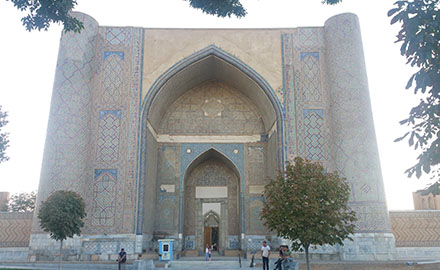 Bibi Khanum Mosque. Legend says that Bibi-Khanym, Timur’s Chinese wife, ordered the mosque built as a surprise while he was away. |
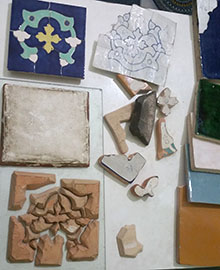 This is how majolica mosaic tiles were made |
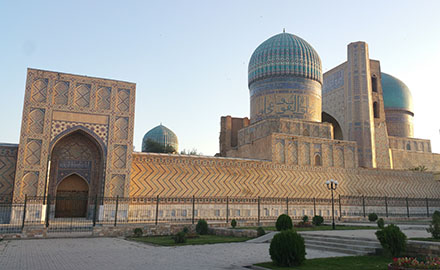 The architect fell madly in love with her and refused to finish the job unless he could give her a kiss. The smooch left a mark and Timur, on seeing it, executed the architect and decreed that women should henceforth wear veils so as not to tempt other men... |
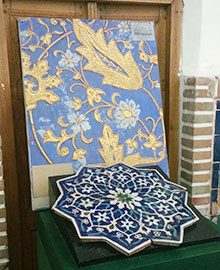 The finished product. Exquisite and beautiful. |
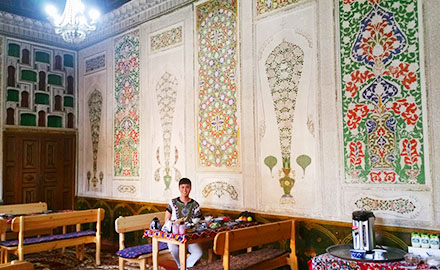 The reception hall of our hotel, which is original and hand painted. Guess it was a noble's home. |
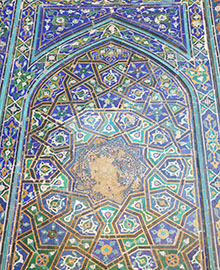 Again, quite exquisite. |
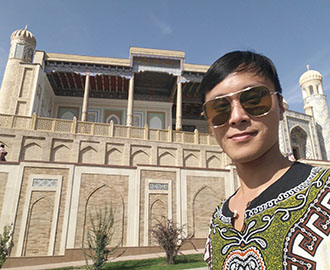 Khazreet Khizr Mosque. Rebuilt of an ancient mosque destroyed by Genghis Khan. |
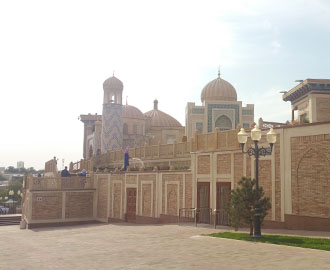 Mausoleum of Islam Karimov, the first President of Republic Uzbekistan for 25 years who just passed away in 2016. |
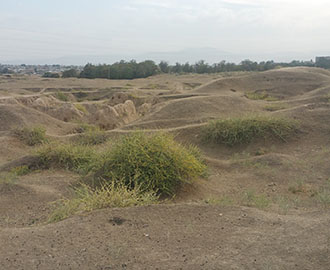 Afrosiab. An unexcavated site north of Samarkand freely for walk. Seems nothing here, but rich history lies underneath. |
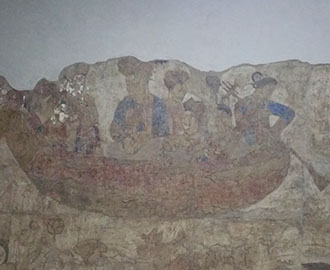 This excavated wall painting depicts Empress Wu Zetian of China sailing on a boat. |
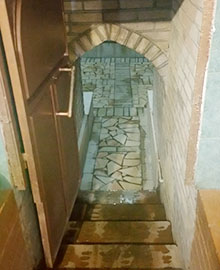 Hammomi Dovudi. The oldest active bath in Samarkand dated back to 19th cen. US$15 for tourist including a scrub/ massage. The process starts with steam, scrub, then rest. |
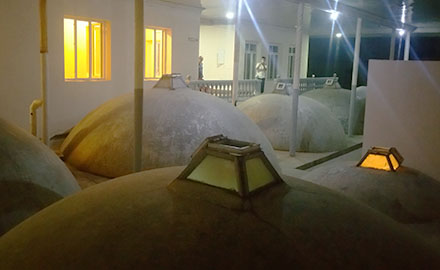 Of the 2 hours from 6pm (peak hr), there were a father with brother and 2 sons, 2 seniors, 1 local and 1 tourist. The body scrub was an enjoyment for ourselves and a show for the rest - we were twisted and turned in almost nude by the skilled master. The ~28 yo fit brother also contributed his share by shaving his sac. An enjoyable open cultural experience. |
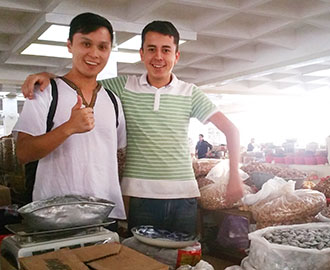 This youth speaks fluent mandarin, so I bought Uzbek pistachio from him. US$12/kg. Later realized it's a very good deal. |
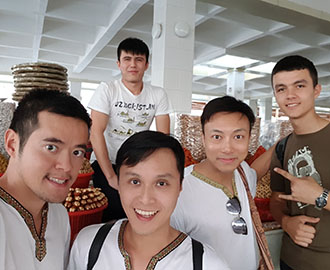 Bought famous sugar coated peanuts from them. It's too too sweet for our taste buds. |
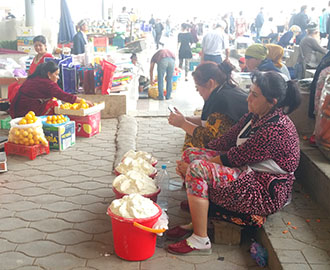 Siab Bazaar. The ancient market of Samarkand. I bought kurut (famous traditional fermented cheese), but only my friends from middle east and Philippine can handle such strong (strange) taste... |
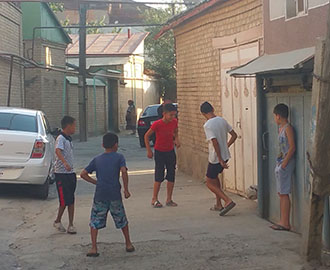 Soccer is amongst their national sports. Despite the language barrier, locals had established conversation with us on world soccer news. Much appreciated of their openness and kindness. |
Tashkent Here at the capital of Uzbekistan we stayed away from mosque/ madrassah/ mausoleum. The city is the newest of those we explored and has much Soviet influence. |
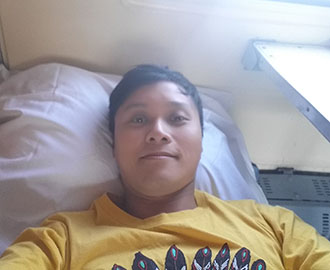 We took the slow train (3hr, US$12) to Tashkent as the fast train tickets got sold fast. |
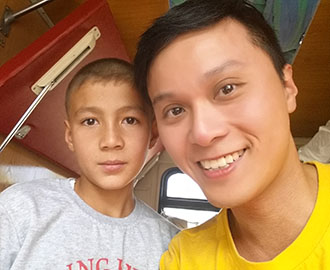 We shared the cabin with this 10 yo boy. His 12 yo bro is a fatty, but definitely he'll be a dandy. |
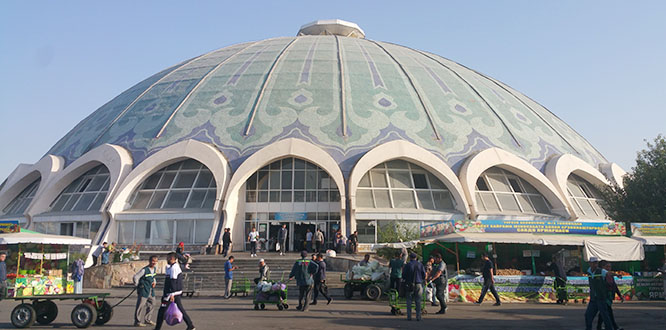 Chorsu Bazaar. The oldest and biggest market in Central Asia which operates on the same spot for over 2,000 years. |
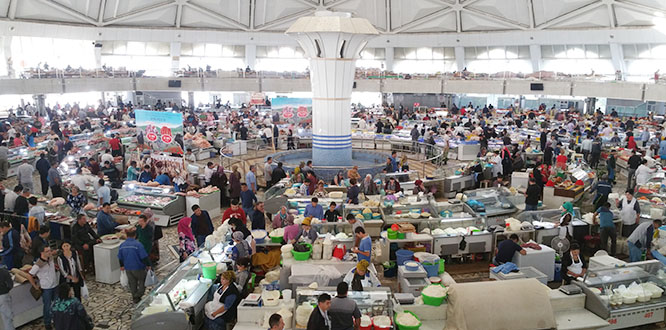 |
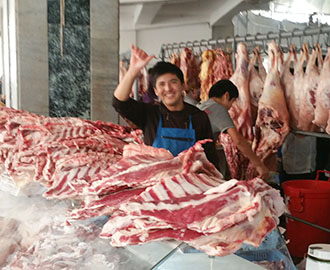 Cute boy selling horse meat. I just assumed these are horse. |
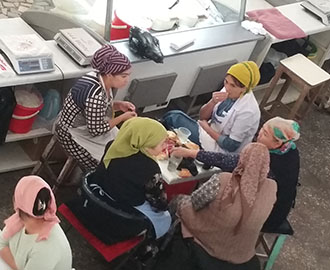 Cheese ladies enjoying their women's time at lunch. |
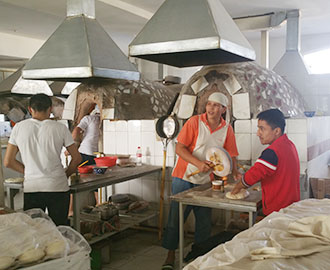 Baking of their traditional non. |
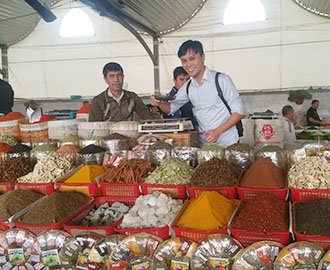 Friendly invite to his shop. |
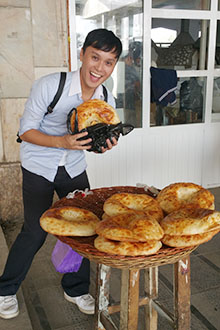 When the non is freshly baked, even plain bread tasted like treat. |
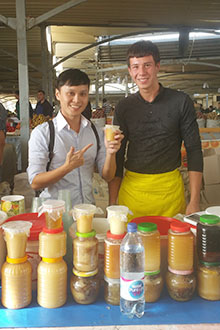 It's dry in desert so bought a small jar of honey. |
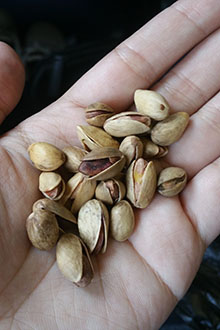 Uzbek pistachio. Smaller than our common ones. |
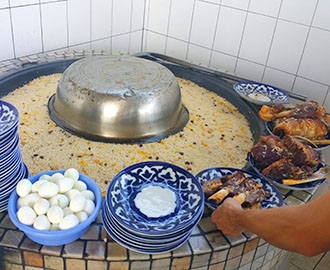 Plov. The national dish with mixture of rice, spices, carrots, mutton, meat, egg, cumin. |
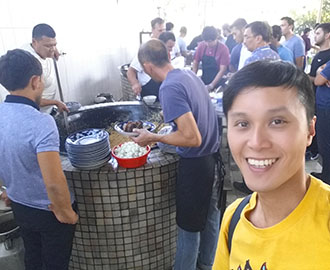 Plov Central (Milli Plov) is the most popular place for plov which can serve over 1,000 guest for lunch. |
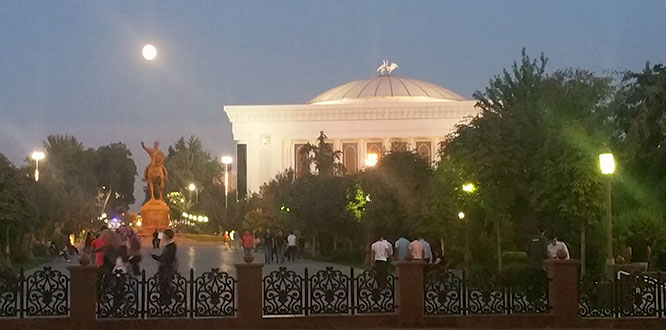 Palace of International Forum. It's Mid-autumn festival and we did receive festive greetings from Uzbek. 但愿人长久,千里共婵娟。 |
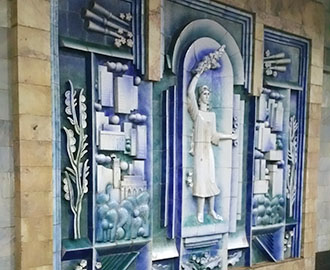 It's a taboo to take picture of the station as the government considers it as a bomb shelter. So I broke the law. |
 Any ride, no matter the distance, is only US$0.25. Quite a norm for socialist country. |
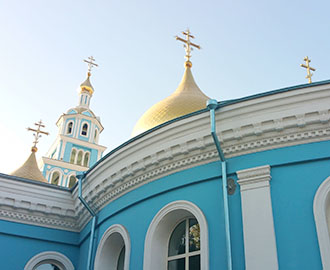 Uspensky Cathedral |
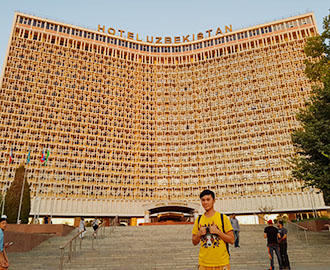 Uzbekistan Hotel maintained under Soviet style (and dated). |
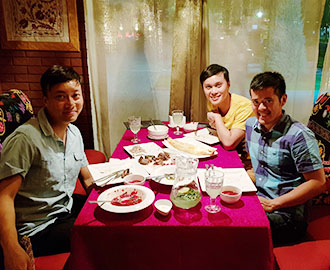 Our last dinner in Uzbekistan. So tried Navat Restaurant for Uzbek fusion cuisine at city center. |
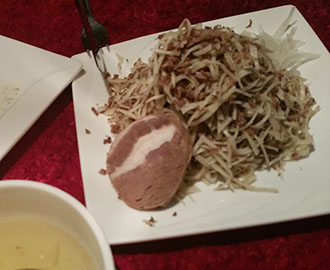 This unique meal was only US$30 in total. We tried this horse meat dish. |
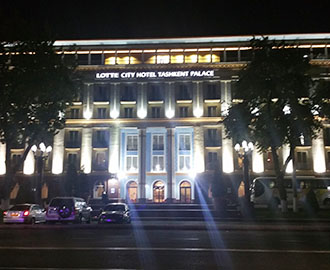 Last day spent at a 5 star Lotte City Hotel. |
 Water was cold in September but nice to have a sun bath. |
|
|
|
|

